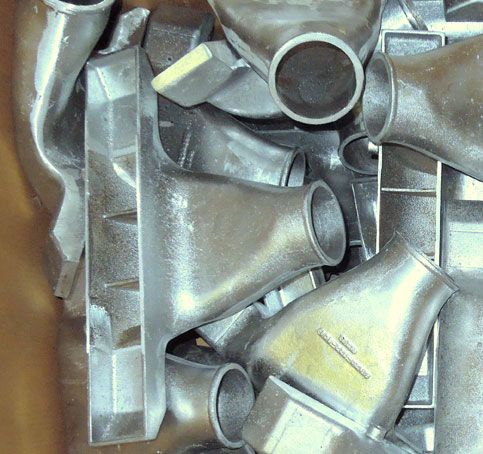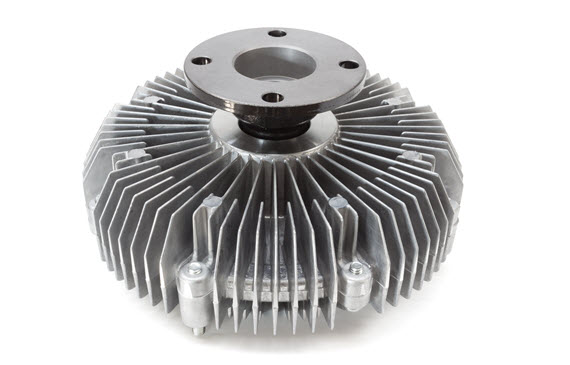Why Aluminum Foundry solutions are trusted by many industries
Discovering the Advantages and Practical Use Aluminum Castings in Today's Market
Light weight aluminum castings have become progressively relevant in different industries as a result of their unique qualities. Their light-weight nature and resistance to deterioration make them appropriate for demanding applications. Furthermore, the superior strength-to-weight ratio supplies considerable advantages in layout and production. As sectors remain to explore their potential, the full extent of aluminum spreadings' advantages and applications stays to be totally uncovered. What lies in advance for this functional material?
The Lightweight Benefit of Aluminum Castings
Many materials are utilized in production, aluminum castings stand out mainly due to their lightweight properties. This characteristic makes light weight aluminum castings an attractive selection for various industries, especially in aerospace and vehicle applications, where weight decrease is crucial for improving fuel efficiency and performance. The lightweight nature of aluminum allows producers to produce elements that are much easier to take care of and install, eventually lowering labor costs.
The capability to produce complex forms without substantial weight charges allows developers to introduce while keeping structural integrity. Light weight aluminum spreadings can properly change much heavier materials, leading to substantial financial savings in delivery and operational prices. Their light-weight benefit additionally contributes to enhanced item durability, as lighter parts usually cause decreased wear and tear on equipment. Generally, the light-weight residential properties of light weight aluminum castings supply manufacturers with a competitive side, cultivating advancements in item style and performance across numerous sectors.

Phenomenal Deterioration Resistance
Aluminum spreadings possess a natural resistance to oxidation, which significantly improves their durability in various settings. This intrinsic residential property not just adds to their toughness however also straightens with the light-weight benefit that light weight aluminum provides. As an outcome, light weight aluminum spreadings are significantly identified for their outstanding rust resistance in various applications.

Naturally Immune to Oxidation
Among the standout attributes of light weight aluminum spreadings is their phenomenal rust resistance, which comes from a natural oxidation process. When revealed to air, light weight aluminum reacts to create a slim, safety layer of light weight aluminum oxide. This layer serves as an obstacle versus more oxidation and secures the underlying metal from harsh aspects such as moisture and salts. Unlike various other steels, this oxide layer is self-repairing; if damaged, it promptly reforms when subjected to air. This unique property enhances the durability of light weight aluminum castings in different atmospheres, making them ideal for applications in industries such as aerospace, auto, and marine. Consequently, the natural resistance to oxidation significantly minimizes upkeep expenses and enhances the integrity of aluminum spreadings sought after problems.
Light-weight Toughness Advantage
The light-weight nature of light weight aluminum castings contributes substantially to their sturdiness, making them a beneficial selection in various industries. This exceptional longevity is mostly credited to light weight aluminum's natural resistance to rust, which is enhanced even more through anodizing and various other surface therapies. Unlike several metals, aluminum does not rust; instead, it creates a safety oxide layer that guards it from ecological damages. This home is particularly helpful in markets such as auto and aerospace, where weight reduction is critical without compromising toughness. In addition, the durability of light weight aluminum spreadings lessens upkeep prices and replacements, providing economic advantages over time. Their light-weight longevity and rust resistance placement light weight aluminum spreadings as a remarkable product for contemporary manufacturing applications.

Superior Strength-to-Weight Proportion
An impressive feature of light weight aluminum spreadings is their superior strength-to-weight proportion, which makes them very desirable in numerous applications. This intrinsic residential property enables aluminum castings to stand up to substantial stress while remaining lightweight, an important consider industries such as aerospace, automotive, and manufacturing. Designers commonly choose aluminum castings for elements that need both resilience and reduced weight, enhancing gas effectiveness and performance.
The high strength-to-weight proportion also helps with the style of complex forms and frameworks, making aluminum castings flexible for facility applications. The capability to preserve structural integrity under challenging conditions guarantees long life and dependability in products, from airplane frameworks to auto parts. This advantage adds to the growing pattern of utilizing aluminum castings in ingenious styles, ultimately resulting in improved performance and effectiveness across varied sectors. Subsequently, the remarkable strength-to-weight proportion of aluminum castings positions them as an essential product in contemporary design and manufacturing.
Cost-Effectiveness in Production
Cost-effectiveness in light weight aluminum casting production is primarily accomplished with decreased material waste and efficient production procedures. By optimizing styles and making use of advanced methods, suppliers can reduce excess material use while keeping quality standards. This method not just lowers production costs but likewise adds to more sustainable techniques within the sector.
Lowered Product Waste
Lowering material waste in aluminum spreading processes greatly boosts production effectiveness. By maximizing the design and production strategies, business can reduce excess scrap and improve resource use. This decrease in waste not just decreases product costs however also adds to a more lasting manufacturing design. The capability to reuse aluminum additional assistances cost-effectiveness, allowing makers to reclaim and reuse products without jeopardizing top quality. As the market significantly concentrates on sustainability, lowered product waste aligns with environmental goals while concurrently increasing success. Ultimately, effective use resources strengthens the competitive placement of services out there, making aluminum spreadings a beneficial option in different applications. The critical strategy to reducing waste reflects a commitment to both ecological and economic responsibility.
Reliable Production Processes
While typical manufacturing processes can sustain significant costs, light weight aluminum casting offers an extra reliable option that improves overall manufacturing success. This approach reduces product waste and permits precise control over the manufacturing process, causing reduced labor and functional costs. The capacity to generate complex forms with less steps even more enhances production, adding to much shorter preparations. Additionally, light weight aluminum's light-weight nature and superb thermal conductivity enable for power savings throughout manufacturing and in the final application. By utilizing modern-day spreading innovations, producers can achieve higher throughput without compromising top quality. Consequently, light weight aluminum spreading sticks out as an economical remedy, making it an attractive choice for services intending to maximize their manufacturing processes in today's open market.
Flexibility Across Industries
Aluminum castings demonstrate amazing flexibility across various sectors, as they can be tailored to fulfill certain requirements and applications. In the automobile industry, aluminum castings are used in engine blocks, transmission housings, and wheels, using light-weight yet sturdy remedies that boost gas effectiveness. The aerospace market also benefits from aluminum castings, using them in architectural elements and engine parts because of their strength-to-weight ratio.
In the consumer items field, makers utilize aluminum castings for items ranging from pots and pans to furniture, giving both aesthetic charm and performance. The electronics sector uses aluminum castings for real estates and warm sinks, making certain effective thermal administration. Additionally, the building and construction sector leverages aluminum castings for architectural components and architectural elements, improving longevity and style flexibility. This wide applicability highlights aluminum spreadings as a necessary resource, fulfilling the diverse requirements of various markets while preserving high performance and dependability.
Sustainability and Environmental Effect
As sectors progressively focus on sustainable techniques, aluminum castings become an environmentally friendly choice due to their recyclability and low environmental impact. Aluminum read is one of the most recycled products worldwide, with the capacity to be repurposed multiple times without deterioration of quality. This characteristic substantially minimizes the need for resources and power usage connected with main light weight aluminum manufacturing, which is energy-intensive.
Furthermore, light weight aluminum spreadings add to lightweight styles, bring about fuel effectiveness in transport applications such as aerospace and automobile sectors. Their longevity and resistance to rust extend item lifespans, better minimizing waste and resource usage over time. In addition, numerous manufacturers are taking on accountable sourcing and eco-friendly manufacturing techniques, improving the sustainability of light weight aluminum spreading procedures. In general, light weight aluminum spreadings stand for a useful solution for services intending to lower their environmental effect while attaining performance and effectiveness.
Developments in Light Weight Aluminum Casting Technologies
Recent advancements in aluminum spreading innovations have substantially boosted the effectiveness and high quality of manufacturing processes. Technologies such as 3D printing and progressed mold-making techniques have actually enabled manufacturers to develop elaborate layouts with minimized material waste. This change not just improves the accuracy learn this here now of cast parts however additionally shortens preparations, permitting for quick prototyping and faster market entrance.
In addition, the consolidation of innovative computer simulations aids in forecasting prospective issues during spreading, leading to higher-quality outcomes (Aluminum Castings). Making use of light-weight alloys has likewise added to the growth of stronger, a lot more sturdy products, satisfying sectors varying from auto to aerospace
Additionally, automated casting processes have emerged, decreasing human mistake and enhancing manufacturing rate. Collectively, these developments are changing the light weight aluminum spreading landscape, driving greater competitiveness and sustainability in manufacturing. As markets remain to evolve, these modern technologies will certainly play an essential role in meeting future demands for efficiency and top quality.
Frequently Asked Questions
Just How Do Light Weight Aluminum Castings Compare to Other Steels in Terms of Thermal Conductivity?
Light weight aluminum castings exhibit exceptional thermal conductivity compared to lots of metals, such as steel and iron - Aluminum Castings. Their lightweight nature and efficient heat distribution make them perfect for applications calling for effective thermal monitoring in various sectors
What Are the Typical Issues Located in Light Weight Aluminum Castings?
Usual issues in light weight aluminum castings include porosity, shrinking, incorporations, and surface abnormalities. These issues often develop from improper cooling prices, poor mold and mildew style, or contaminations, influencing the overall high quality and performance of the end product.
Can Aluminum Castings Be Recycled, and How?
Light weight aluminum spreadings can be reused properly. The procedure involves accumulating, melting, and changing the aluminum, which reduces waste and saves sources. This reusing adds to sustainability while maintaining the product's homes for future use.
What Are the Typical Lead Times for Aluminum Spreading Production?
Typically, preparations for aluminum spreading manufacturing array from two to 6 weeks, depending upon elements such as intricacy, tooling requirements, and production quantity. Effectiveness can improve with well-known provider partnerships and optimized production processes.
Exactly how Does the Surface Complete Affect Light Weight Aluminum Casting Efficiency?
The surface area finish noticeably impacts light weight aluminum spreading performance by affecting rust resistance, visual quality, and rubbing characteristics. A smoother surface boosts resilience and performance, while a rougher appearance can boost bond for subsequent coatings or therapies.
Many materials are utilized in manufacturing, light weight aluminum castings stand out mostly due to their lightweight buildings. When revealed to air, aluminum reacts to create a thin, safety layer of aluminum see here oxide. Cost-effectiveness in light weight aluminum spreading manufacturing is primarily achieved with minimized product waste and reliable production processes. Lowering material waste in aluminum spreading procedures greatly improves production effectiveness. Eventually, reliable use of raw products enhances the affordable placement of organizations in the market, making light weight aluminum spreadings a desirable option in different applications.